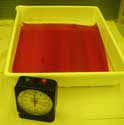
A & B Developer Powder for Gelatin Based Indirect Photographic Films
Ulanoprex
Quasar R 100
Super Prep®
Blue Poly®-2 and 3
Red TI®
Hi-Fi Green®
A & B Developer Powders are paired bottles of pre-measured, pre-weighed dry ingredients that are dissolved in tap water to make fresh developer solution for Ulano gelatin-based (iron salt sensitized) indirect system, photographic stencil films.
| Product Code | Makes | per box | Boxes per case | |
| ABP | Pint 473 cc | 8 | 20 | |
| ABQ | Quart 946 cc | 20 | 6 | |
| ABG | Gallon 3.8 liters | 20 | 2 |
A & B Developer Powders are pre-measured for mixing pints, quarts, or gallons of developer solution. As a user of Ulano Indirect System Photographic Films, A & B Developer Powders remain your best assurance that the developing step will be a constant in your stencil processing.

Because A & B Developer bottles are tightly sealed, the contents will not degenerate in storage (unlike hydrogen peroxide). This assures absolute freshness and proper concentration of the developer solution. A & B Developer Powders contain special buffers that minimize the effect of mineral content in your water. Pre-weighed, pre-mixed, fresh-until-opened A & B Developing Powders effectively eliminate any variables in the developing step when you process indirect system gelatin-based films.
Tech Data SheetINSTRUCTIONS
Step 1: DISSOLVE THE DEVELOPER POWDERS
Select pint, quart, or gallon sized bottles of A&B Developer Powders
based on the size of the stencil (and developing tray) and the need to
cover the film with a minimum of 1 - 2 inches (2 ½ - 5 cm.) of developer
solution. Measure out a pint, quart, or gallon of water. When opening
A&B Developer Powders and adding them to water, make it a rule to tap
each bottle four times to be sure that all the powder releases from the
bottle. Dissolve the "A" Powder first, then add the "B" Powder. (This
hastens the dissolving of the "B" Powder.) Stir the developer solution
or, for faster dissolving of A&B Developer Powders, shake them with the
water in a covered jar. The developing of indirect system stencil films,
like all chemical reactions, is hastened or slowed by changes in temperature;
developing times are predicated on developer that is within a normal room
temperature range--between 64° and 75° Fahrenheit (18° - 24° Celsius).
Dissolving A&B Developer Powders in water causes an exothermic reaction,
lowering the temperature of the solution. Thus, before developing Ulano
gelatin-based indirect stencils, be sure that the developer solution is,
indeed, within the recommended temperature range. As the film is light
sensitive (to upper-UV and visible blue light), work under yellow safelight
conditions or subdued lighting.
Step 2: DEVELOP THE FILM
Developing completes the hardening reaction initiated by light energy during
exposure. Uniform, even wetting of the entire surface of the film
assures uniform stencil thickness and hardness, especially for critical
work. We do not recommend trying to place film in a developer tray that
is already full of developer.
- Place the film in a dry tray, emulsion side up.
- Tilt the tray slightly, then pour the developer over the surface of the film quickly and evenly.
- Rock the tray occasionally during developing to circulate fresh developer over the surface of the film.
- Develop Hi-Fi Green, Super Prep, Blue Poly, and Red TI for 1½ minutes (90 seconds).
Develop Ulanoprex for 3 minutes (180 seconds). - After the first piece of film has been developed, some light-sensitive emulsion floats off into the developer, making it light sensitive. To prolong the life of the developer, keep the developer tray covered when not in use.
Note: Do not store developer solution in a closed container after it is
used. It will release oxygen under pressure. Discard used developer solution
at the end of each workday.
TANK DEVELOPING OPTION
Developing indirect system photographic stencil films in a specially constructed
tank is a useful option, especially for the production of large stencils--with
the additional advantage that the developer can be used for several days
because it is protected against light and continuous contact with air. We
suggest the use of a piece of rigid plexiglass with one side "frosted" and
onto which the exposed film is taped. (After developing, the plexiglass
serves as a buildup board during the adhering step.) A counterweight arrangement
will make it easy to lower and raise the plexiglass and film in and out
of the developer bath.
PLEASE NOTE: A & B Developer Powders are supplied in sturdy plastic bottles and each box contains equal amounts of A Powder and B Powder Bottles.